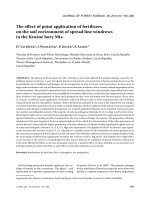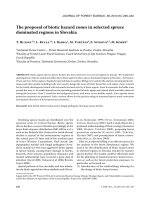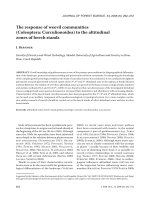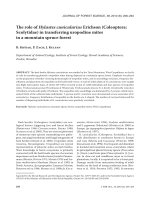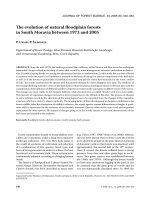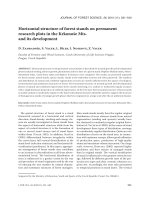Báo cáo lâm nghiệp: "The effects of transplanting stress on photosynthesis, stomatal conductance and leaf water potential in Cedrus atlantica Manetti seedlings: role of root regeneration" pdf
Bạn đang xem bản rút gọn của tài liệu. Xem và tải ngay bản đầy đủ của tài liệu tại đây (190.62 KB, 5 trang )
The
effects
of
transplanting
stress
on
photosynthesis,
stomatal
conductance
and
leaf
water
potential
in
Cedrus
atlantica
Manetti
seedlings:
role
of
root
regeneration
J.M.
Guehl
1
G.
Aussenac
1
P.
Kaushal
2
1
Laboratoire
de
Bioctimatologie
et
Ecophysiologie
Foreshore,
Station
de
Sylviculture
et
Production,
INRA,
Centre
de
Nancy,
Champenoux,
54280
Seichamps,
France,
and
2
Department
of
Forestry
and
Natural
Resources,
Punjab
Agricultural
University,
Ludhiana,
141 004
India
Introduction
Artificial
forest
stand
establishment
may
be
achieved
either
with
container-grown
seedlings
or
with
bareroot
planting
stock.
Since
growing
seedlings
in
containers
may
lead
to
abnormal
root
development
after
transplanting
(Aussenac
et aL,
1988),
renewed
attention
should
be
given
to
bareroot
planting.
Bareroot
transplanting
is
accompanied
by
a
specific
transplanting
stress,
that
may
lead
to
substantial
plant
mortality
or
re-
duced
growth,
due
to
the
disturbance
of
the
functional
continuity
at
the
soil-root
interface
(Sands,
1984),
or
to
mechanical
damage
to
roots
caused
by
lifting
the
plants
from
the
nursery
beds
(Chung
and
Kramer,
1975).
Physiological
processes,
such
as
C0
2
assimilation
and
translocation
(Stupendick
and
Shepherd,
1980),
stomatal
conduc-
tance
and
plant
water
status
(Sands,
1984;
Kaushal
et al.,
1987;
Aussenac
and
El
Nour,
198i3),
considered
separately,
have
been
shown
to
be
affected
signifi-
cantly
by
transplanting.
However,
a
satis-
factory
rationale
for
studying
effects
of
transplanting
should
also
include
valuable
information
on
the
possible
linkages
be-
tween
these
processes
and
the
inter-
relationships
with
root
regeneration
after
transplanting.
Materials
and
Methods
One
yr
old
seedl’ings
were
transplanted
from
a
nursery
to
a
glasshouse
in
polyethylene
bags
(16
x
60
cm)
containing
sphagnum
peat
and
were
maintained
well-watered.
One
yr
later,
in
October
1985,
half
of
the
plants
were
lifted
from
the
bags,
stored
for
20
h
at
20°C,
100%
relative
humidity
and
in
darkness,
and
then
planted
again
in
similar
bags.
The
other
half
(control
plants)
were
maintained
in
the
initial
bags.
The
carbon
dioxide
<assimilation
rate
(A),
stomatal
conductance
(g
s)
and
predawn
needle
water
potential
(V
p)
0
1’
these
seedlings
were
mea-
sured
just
prior
to
transplanting
(day
0),
and
on
days
2,
9,
16,
23
and
30
after
trans-
planting.
In
experiment
2,
seedlings
were
transplanted
in
minirhizotrons.
The
plants
were
given
optimal
fertilization
and
the
root
systems
were
main-
tained
at
20°C
in
order
to
promote
root
regen-
eration.
Assimilation
rate
measurements
and
root
observations
(number
of
growing
roots
and
root
elongation)
were
made
just
before
trans-
planting
(day
0)
and
then
weekly
from
day
7
to
day
49
after
transplanting.
Gas
exchange
measurements
were
made
with
a
classical
open
system
under
standard
environmental
conditions.
In
experiment
1,
intercellular
C0
2
concentration
(c
i)
values
were
calculated
from
the A
and
gs
data,
which
per-
mits
assessment
of
the
extent
to
which
changes
of A
following
transplanting
are
due
to
reduced
diffusional
supply
of
C0
2
to
the
mesophyll
or
to
decreasing
mesophyll
photosynthetic
capacity
(Jones,
1985).
In
an
A
vs
ci
plot,
these
2
limita-
tions
are
represented
by
the
supply
(Su)
and
demand
(D)
functions,
respectively
(see
Fig.
2).
Results
Experiment
1
In
the
transplanted
seedlings,
a
marked
and
parallel
decline
in
both
C0
2
assimila-
tion
and
stomatal
conductance
occurred
from
day
0
to
day
9
after
transplanting
(Fig.
1a
and
b);
afterwards
the
decline
continued,
but
was
less
pronounced.
The
control
plants
presented
a
decreasing
trend
of
gas
exchange,
but
the
decline
was
significantly
less
pronounced
than
in
the
transplanted
plants.
Predawn
needle
water
potential
(Fig.
1c)
was
affected
by
transplanting,
but
significantly
lower
values
than
in
the
control
plants
occurred
only
after
day
9.
The
severe
decline
in
A
t-
for
the
transplanted
plants
was
accompa-
nied
by
an
almost
constant
ci
(Fig.
2),
thus
indicating
that,
despite
the
parallel
evolu-
tion
of
A
and
gs,
the
changes
in
Awere
mainly
due
to
an
alteration
of
mesophyll
photosynthetic
capacity.
Experiment
2
Carbon
dioxide
assimilation
A
markedly
and
gradually
decreased
after
trans-
planting
from
day
0
to
day
14
(Fig.
3a),
and
then,
from
day
14
to
day
42,
recov-
ered
its
initial
value.
The
start
of
recovery
in
A
was
concomitant
to
the
beginning
root
regeneration
(Fig.
3).
Discussion
The
results
of
this
study
support
the
pre-
vious
findings
of
several
authors
showing
that
A
(Stupendick
and
Shepherd,
1980),
gs
and
WP
(Sands,
1984;
Aussenac
and
El
Nour,
1986)
are
affected
by
transplanting
stress.
However,
the
decline
of
A
due
to
trans-
planting
was
not
a
consequence
of
re-
duced
gs,
but
was
primarily
determined
by
alterations
of
mesophyll
photosynthesis.
This,
plus
the
parallel
time
course
of
A
and
gs,
might
even
suggest
that
reduced
gs
is
the
consequence
of
altered
meso-
phyll
photosynthesis.
Leaf
water
status
is
not
the
factor
re-
sponsible
for
the
initial
decline
of A
and
gs,
but
it
is
likely
to
be
a
relevant
physiological
constraint.
The
(common?)
signal
that
trig-
gers
the
initial
decline
in
A
and
gs
remains
unknown
(nutritional,
hormonal?).
Recovery
of A
was
strictly
concomitant
with
root
regeneration,
but
no
evidence
could
be
found
to
ascertain
whether
a
functional
linkage
exists
between
these
2
parameters,
or
whether
they
respond
to
a
third,
still
unknown,
factor.
References
Aussenac
G.
&
E:I
Nour
M.
(1986)
Evolution
du
potentiel
hydrique
et
du
syst6me
racinaire
de
jeunes
plants
de
c6dre,
pin
laricio
de
Corse
et
pin
noir
plantés
A I’automne
et
au
printemps.
Ann.
Sci.
For.
43, 1-14
4
Aussenac
G.,
Guehl
J.M.,
Kaushal
P.,
Granier
A.
&
Grieu
P.
(-1988)
Crit6res
physiologiques
pour
1’6valuation
de
la
qualitd
des
plants
fores-
tiers
avant
plantation.
Rev.
For.
Fr.
40, 131-139
Chung
H.H.
&
Kr,amer
P.J.
(1975)
Absorption
of
water
and
32
P
through
suberized
and
unsuber-
ized
roots
of
lobl,olly
pine.
Can.
J.
For.
Res.
5,
229-235
Jones
H.G.
(19Ei5)
Partitioning
stomatal
and
non-stomatal
limitations
to
photosynthesis.
Plant
Cell
Environ.
8,
95-104
Kaushal
P.K.
(1987)
Analyse
6cophysiologique
des
effets
de
stress
liés
aux
transplanta-
tions
des
arbres
forestiers.
Thesis,
University
of
Nancy,
France
Sands
R.
(1984)
Transplanting
stress
in
radiata
pine.
Aust.
J.
For.
Res.
14,
67-72
Stupendick J.A.T.
&
Shepherd
K.R.
(1980)
Root
regeneration
of
root-pruned
Pinus
radiata
seed-
lings.
II.
Effect
of
root
pruning
on
photosynthe-
sis
and
translocation.
New
Zealand
J.
For.
Sci.
148-158



